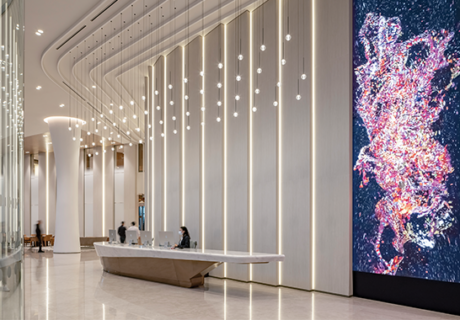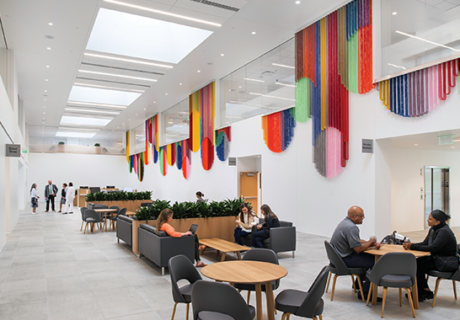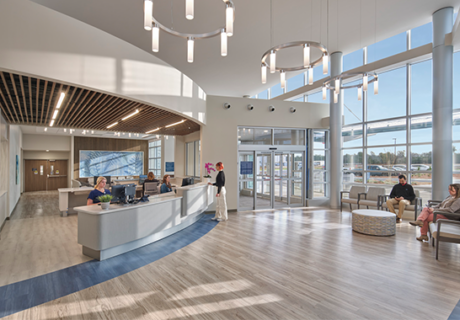Seeds of Change: Shunde Hospital
The 3 million-square-foot Shunde Hospital of Southern Medical University opened in January in the Cantonese city of Shunde in southeastern China. Designed by HMC Architects (Los Angeles) in collaboration with Shunde Architectural Design Institute (Shunde), it combines Western healthcare innovations with local Chinese practices in a 2,000-bed facility. In addition to two inpatient towers and a three-tower ambulatory care center designed to handle 6,000 outpatients a day, the campus also includes a cancer center; physical therapy facility; medical research labs; an infectious disease building; an administrative block; and a staff center comprising a dormitory, cafeteria, and conference facilities. And, most notably, it was designed with impressive green features.
“Sustainable design is a relatively new concept for this region’s medical centers,” says Kirk Rose, healthcare practice leader at HMC Architects. But because the Chinese government has adopted energy conservation and the reduction of emissions as part of its basic national policy, there’s strong support for innovation in design and construction to implement this priority. When HMC’s sustainability strategies for Shunde came to the attention of the state government, the project was designated as the first official pilot green hospital, informing the ongoing development of China’s green guide for hospital design.
Nature inspired
The hospital is organized into a series of six buildings connected by an atrium. Outside, courtyards provide a welcome public space in the dense city and a place for activities such as traditional dancing and festivals. The configuration also contributes to the hospital’s environmental performance. Sited lengthwise along an east-west axis for optimal solar orientation, the blocks shade the outdoor areas for 60 to 70 percent of the day. The courtyards, open to the east, catch and cool the prevailing winds. This cooled air is then harvested and introduced into the atrium, where operable skylights create a stack effect that allows the space to be passively ventilated for three or four months of the year.
In addition to configuring the building’s mass and orientation to reduce cooling loads, create microclimates, and harvest seasonal winds, key environmental building strategies include rainwater capture for irrigation and passive cooling and vast arrays of building-integrated photovoltaics (BIPV) for renewable electricity. Another sustainable strategy was to use insolation, or the measurement of the intensity of incoming solar radiation on an object, to determine the composition of the façades. A computer-based solar analysis was conducted to map the entire building envelope, so the architect could select the most energy-effective element—such as photovoltaic panel, shading device, balcony, glass, or white metal cladding—for any location. “The solar map became the aesthetics of the building,” says Raymond Pan, principal at HMC and design lead on the project.
For example, photovoltaic panels are used in two ways: passively, as shading louvres on major south-facing façades, the roof, and the atrium skylight, and actively, as a source of renewable energy supplying an estimated 25 percent of the building’s needs. A total of 120,000 square feet of BIPV make Shunde the first hospital application of the technology in China, and one of the largest such applications in the world. Preliminary results from the first eight months of operation indicate that the BIPV system is projected to generate 120 kWh by the end of the year, equivalent to approximately $160,000 in electricity savings.
Instead of importing the panels, the design team worked with South China University of Technology and a local solar panel manufacturer to develop a new supply of panels suitable for integrating into architecture (as opposed to standing in a field), complete with specially engineered structural and electrical connections. On the south façades, photovoltaic louvres are supported on an exoskeleton held approximately 3 feet off the building’s skin, while rooftop panels are supported on a horizontal trellis.
A different treatment was required for the long west face of the atrium, which isn’t suitable for energy collection yet still requires shading from the afternoon sun. The solution—a sinuous brise soleil that the local community has dubbed “the dragon’s tail”—became the hospital’s signature element. The structure’s slats are made of extruded aluminum tubing and mounted onto an armature set about five feet from the atrium curtain wall. The air space behind the shading device ventilates the structure, preventing the heat it absorbs from re-radiating onto the glass.
Heat mitigation strategies also extend to the building’s fifth façade, the roof, where two approaches were implemented to lower the building’s cooling needs and reduce its contribution to the urban heat island effect. In the areas best suited for generating solar power, photovoltaic panels shade the roof, while the remaining unshaded roof is surfaced with a high-albedo finish (a light-colored concrete) to reflect solar radiation.
Further reducing the building’s energy needs, 80 percent of the public areas, such as the lobby, atrium, and waiting area, are daylit, as are all the patient rooms.
Cultural effect
Despite the novelty of many of these sustainability measures, Pan says the design team didn’t struggle to get approval to implement them because the Chinese are keen to adopt international best practices. Additionally, the traditional Chinese lifestyle is inherently resource-conscious, he says. For example, light sensors were unnecessary in the hospital because turning off lights when leaving a room is customary. The number of elevators was able to be reduced by one-third compared to North American standards because the client insisted that people don’t mind waiting or taking the stairs. And rainwater collection for irrigation and cooling is a common practice dating back thousands of years, so it was just a matter of translating this familiar strategy into the technology of cisterns and pipes, Pan says.
The only major sustainability initiative from the original scheme that proved impossible to implement was chilled beams, a highly efficient, convection-based environmental control system—a system too foreign for local consultants to embrace, Pan says.
Altogether, Shunde Hospital was designed to outperform local energy regulations by more than 60 percent, although subsequent equipment selections have reduced those predicted gains to 40 percent. With the hospital having been open for less than a year, and commissioning still in progress, it’s too early to evaluate actual consumption, says Eric Carbonnier, sustainability vice president at HMC Architects. However, Carbonnier anticipates being able to cross-check the design team’s computer-based modeling with data from hospital operations in a couple of years. “Post-occupancy data will be crucial to understanding how we advance future projects,” he says. Through its influence on the ongoing development of China’s green guide for hospital design, that data will also be helpful to the evolution of sustainable technologies for future hospitals in the country.
Katharine Logan is an independent writer based in Victoria, British Columbia, Canada. She can be reached through her website at katharinelogan.com.
Preventive medicine
The city of Shunde, China, is long famous for its food, canals, and terra cotta. But the 3 million-square-foot Shunde Hospital of Southern Medical University serves as a new claim to fame. For a second-tier city of only 3 million people, a hospital this large is extraordinary. For example, a hospital in nearby Shenzhen, a city of 17 million, is only slightly bigger.
The reasons for this massive addition in Shunde trace back to the 2002 outbreak of severe acute respiratory syndrome (SARS), the world’s first case of which was identified in the city’s previous hospital. The disease became a global epidemic, affecting thousands of people in 26 countries and killing hundreds in its brief but virulent rampage.
In southern China, the crisis catalyzed major changes in policy and emergency response. The government’s intent to prevent such a thing from reoccurring, and to give back to the community that suffered, led to the design and construction of the project.
The sheer size of Shunde Hospital presented an initial architectural challenge. “To design a building this scale, you have to think like an urban planner,” says Raymond Pan, a principal at HMC Architects and design lead for the project.
To that end, the hospital’s design based on six distinct buildings connected by an atrium provides a clear logic for future expansion. It responds to the initial inspiration for the project, as well. If a contagion ever presents itself again, each of the blocks can be decoupled and isolated from the rest of the hospital.












